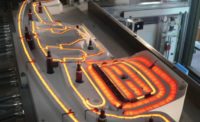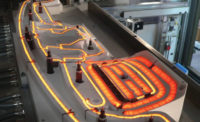Washers are a vital component of many fastened joints. Washers are critical to the operation of virtually every device with moving parts. They perform a variety of functions beyond just securing bolts, nuts, screws and rivets. They can insulate, seal, lock, provide spacing, improve appearance, supply spring force, align parts, and distribute loads.
With seemingly limitless varieties of washers available, it is important to select the most optimal type for your specific application. Failure to specify the correct washer can result in machine downtime and lost production.
Washer Materials
Any type of material that can be stamped can be made into a washer. Washers are manufactured in a broad range of metallic and nonmetallic materials, including low- and high-carbon steels, stainless steel and steel alloys, copper-based materials, beryllium copper, phosphor bronze, titanium, aluminum, fiber, mica, polyester, rubber, nylon, PTFE and phenolic.
Material selection is important, because some applications require a specific material to ensure the washer withstands environmental conditions. For example, if a washer will go through cyclic loading, strength and fatigue resistance will be important design criteria. As a result, high-alloyed steels or spring steel may be required. Alternatively, nonmetallic materials can be used when washers are subjected to lighter loads or if they will be used on soft surfaces that could be damaged by a metallic washer.
Washer Styles
A variety of washer styles are available today. This article will discuss the six basic types of washers: flat, shoulder, tab, lock, countersunk and spring. I’ll also discuss a few specialty styles.
The most common washer category is the flat washer, which includes a large number of washer configurations. These washers are thin, flat and circular general-purpose washers with a centrally located hole. Internal and external shapes may be round, symmetrically square, hexagonal or rectangular. They also may be nonsymmetrical depending on the function of the washer.
Shoulder washers, also known as step or flange washers, have an integral cylindrical sleeve , giving them the appearance of a low-crowned top hat. The sleeve is designed to mate with a cutout and segregates the fastener from the material it is secured to. Made of nonconductive materials, these washers are used primarily as insulators in the electronic equipment industry.
Tab washers are a type of lock washer, round in shape and often manufactured with a single tab or multiple tabs and notches that can be formed to shape around bolts or nuts or designed to lay flat. These washers are ideal for use in harsh environments, effectively locking a part into place in applications subjected to extreme heat or heavy vibrations.
Lock washers are designed to secure fasteners that tend to rotate or lose friction. Lock washers exert a load, partially deform and lock a fastener in place. A split coil or teeth of the lock washer bite into the head of the fastener and against another flat surface. In some applications they are deployed along with a flat washer to distribute the load evenly without deforming the assembly that the fastener is secured to.
Countersunk washers, also referred to as finishing washers, have a countersink that captures the head of the fastener. When secured, they provide a flush surface and are available in several shapes including 90-degree countersunk, angle countersunk, flanged, unflanged, and rolled flange. These washers are often found on consumer products.
Also known as disc springs, spring washers feature irregularities that compress with a proportionate resistance to return to their pre-deflected shape. Spring washers are employed in applications where assemblies need a part to take up play, maintain assembly tension, compensate for expansion or contraction in materials, or to absorb intermittent shock loads and provide a controlled reaction under dynamic loads.
Spring washers are economical, small and generally weigh less than alternative fasteners. There are three basic types of spring washers: cylindrically curved, wave and Belleville.
Cylindrically curved washers—also known as crescent, bowed or curved washers—have the most uniform spring constant over the widest deflection range of any of the spring washer types. Their spring rate is approximately linear throughout the entire deflection range. These washers are ideal for lighter loads, ranging from a few ounces to about 100 pounds. They are ideal for flexible, load-cycling applications.
Wave washers, sometimes referred to as wave springs, have multiple waves—generally three, four or six—and are available in many sizes. By increasing the number of waves, the thickness can be reduced for a given load, but only by decreasing the amount of deflection and increasing the radial stress. Wave uniformity is important because the load or deflection rate will not start until all waves are evenly loaded. Wave washers are ideal for obtaining loads when the load is static or the working range is small and the amount of axial space is limited. These washers are typically used as cushions or spacers to take up variations in assembled parts.
Belleville washers are often described as conical or spherical spring washers, as they have the form of a truncated cone or truncated sphere. These washers have the smallest deflection ranges and the highest load capacity of any of the three types of spring washers. The load and deflection capability is dependent on their height-to-thickness ratio. Belleville washers are common in thermal expansion applications, and are used to solve spring problems of high loads, limited space and small deflections.
Valve shim stacks feature a smooth finishing design to ensure shim stacks work together to dampen suspension movement. With exact, consistent thicknesses, inside diameters and outside diameters, shim stacks are ideal for simple and complex applications. Valve shims can be heat-treated to operate at higher temperatures without losing strength. They are optimal for achieving precise spacing or filling space between mismatched components.
Fender washers have a large outside diameter in comparison to their inside diameter. Their name, fender, is derived from their use in the automotive industry to mount fenders. Fender washers distribute a load evenly across a large surface area. Flat washers with outer diameters measuring more than three times their inner diameters are commonly referred to as fender washers.
Washer Selection
In addition to determining washer material and style, it is important to consider additional factors before specifying a washer. These factors include tolerances, material and thickness, temper, hardness and heat treating, compatibility, flatness, burrs and finish.
As a general rule, the tighter the tolerances, the more expensive the part. Washer tolerances should be specified in accordance with accepted industry standards.
Material and thickness selection should be based upon application requirements and within standard tolerances. For example, using a corrosion-resistant alloy in place of a steel part with an anticorrosion plating may result in significant savings.
If hardness is of no importance to an application, temper does not need to be specified. If hardness needs to be specified on heat-treated parts, it should comply with standard ranges for the material.
All specifications, such as a washer’s physical dimensions, heat treatment and load, must be mutually compatible to ensure optimal performance.
Industry guidelines recommend that flatness should not be greater than 0.01 total indicator reading per inch of outside diameter to eliminate expensive secondary operations, such as grinding or flattening on special tooling.
Burrs—ragged, sharp protrusions on the edges of metal stampings—should be considered. Deburring operations can result in additional costs.
Surface finish or coatings can be used to improve appearance or corrosion resistance on a washer. They can also help with error-proofing. For example, color-coding can help assemblers distinguish between washers of various thicknesses. Washers that are 0.005-inch thick can be colored green, while 0.008-inch thick washers can be colored orange.
While the above factors provide a helpful guide in understanding and specifying washers, engineers can benefit from the experience and capability of an established washer manufacturer that consistently solves unique problems ranging from engineering and custom manufacturing. Engineers are well-advised to consult with a washer supplier as early as possible in the design process.









